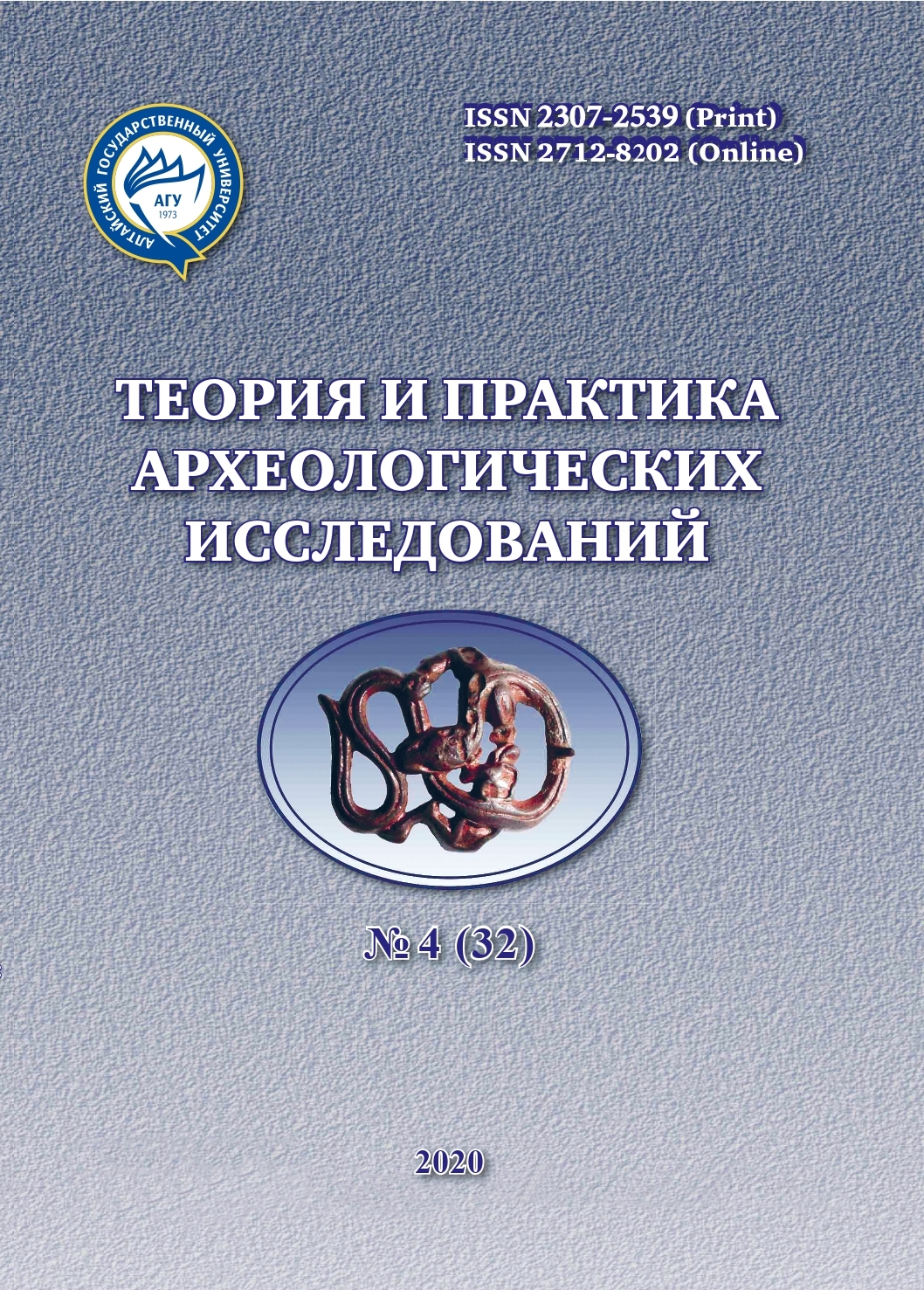A CONNECTION BETWEEN THE SETTLEMENT DYNAMIC OF THE EASTERN PAMIR AND PALEOCLIMATIC CHANGES IN THE LATE GLACIAL AND HOLOCENE
Abstract
This article is devoted to a review of the data on the chronology of the occupation of the Eastern Pamirs high-lands and the paleoecological reconstructions. At this moment it is known that there are two main episodes of the settlement of the region in the Final Pleistocene – Middle Holocene: 12–8 ka BP. (the main archaeological sites are the Istyk cave and the Kurteke grotto) and 8–6 thousand years ago (Oshkhona, Shakhty, Istykskaya cave, Kurteke). The review shows that these episodes coincide with the periods of the most favorable paleoclimatic conditions. The climate of the region in general is characterized as arid desert, with a predominance of open spaces of desert-steppe and desert appearance. The time intervals about 15–13 thousand years ago and about 9–8 thousand years ago are characterized with a transition from xerophilic groups to more mesophilic, which indicates a humidification of the climate during these periods. The researchers note that these climatic changes are likely to be pan-regional. The revealed cyclicality of climate changes in the Eastern Pamir region is comparable to archaeological data: the time intervals in when an increase in the climate humidity of the region is noted are similar to the intervals in when, according to archaeological data, the region was populated. Further paleoecological reconstructions of the Eastern Pamirs will reveal the connection between the cyclicality of climatic changes in the region and human settlement in its territory.
Downloads
Metrics
No metrics found.
References
Zhilich S.V., Shnajder S.V., Rudaya N.A. K voprosu o vydelenii pyl’cy kul’turnyh zlakov na arheologicheskih pamyatnikah na primere pamyatnika Kurteke (Tadzhikistan) [Palynological Evidence of Cultivated Grain Crops at the Archaeological Site of Kurteke (Tajikistan)]. Problemy arheologii, etnografii, antropologii Sibiri i sopredel’nyh territorij [Problems of Archaeology, Ethnography, Anthropology of Siberia and Adjacent Territories]. 2019. Vol. XXV. Pp. 388–395. DOI: 10.17746/2658-6193.2019.25.388-395.
Nikonov A.A., Ershova L.N. Novye dannye o golocenovom klimaticheskom optimume v Pamiro- Alae [New Data on the Holocene Climatic Optimum in the Pamir-Alai]. Doklady Akademii nauk Tadzhikskoj SSR [Reports of the Academy of Sciences of the Tajik SSR]. 1981. Vol. XXIV. №11. Pp. 687–690.
Ranov V.A. Pamir i problema zaseleniya vysokogornoj Azii chelovekom kamennogo veka [Pamir and the Problem of Settling High-Mountainous Asia by Stone Age Man]. Strany i narody Vostoka [Countries and Peoples of the East]. 1975. Pp. 137–167.
Ranov V.A., Hudzhageldiev T.U. Kamennyj vek [The Stone Age]. Istoriya Gorno-Badahshanskoj avtonomnoj oblasti [The History of the Gorno-Badakhshan Autonomous Region]. 2005. Vol. 1. Pp. 51–107.
Saidov A.S. Mlekopitayushchie (Mammalia) Pamira: voprosy ohrany i upravleniya resursami [Mammals (Mammalia) of the Pamirs: Issues of Conservation and Management of Resources]. Izv. Akademii nauk respubliki Tadzhikistan, otd. biol. i med. nauk [Bulletin of the Academy of Sciences of the Republic of Tajikistan, Department of Bilogocal and Medical Sciences]. 2008. №3 (164). P. 36–49.
Shnajder S.V., Saifuloev N.N., Alisher-kyzy S., Rudaya N.A., Dedov I.E., Zotkina L.V., Zhukov V.A., Karaev A., Navruzbekov M., Aleksejceva V.V., Krivoshapkin A.I. Pervye dannye izucheniya mnogoslojnogo pamyatnika Istykskaya peshchera (Vostochnyj Pamir, Tadzhikistan) [The First Data from the Study of the Multilayer Site Istyk Cave (Eastern Pamir, Tajikistan)]. Problemy arheologii, etnografii, antropologii Sibiri i sopredel’nyh territorij [Problems of Archaeology, Ethnography, Anthropology of Siberia and Adjacent Territories]. 2019. Vol. XXV. Pp. 293–298. https://doi.org/10.17746/2658-6193.2019.25.293-298.
Heinecke L, Epp L.S., Reschke M., Stoof-Leichsenring K.R., Mischke S., Plessen B., Herzschuh U. Aquatic Macrophyte Dynamics in Lake Karakul (Eastern Pamir) over the Last 29 cal ka Revealed by Sedimentary Ancient DNA and Geochemical Analyses of Macrofossil Remains. Journal of Paleolimnology. 2017. Vol. 58. Pp. 403–417. https://doi.org/10.1007/s10933-017-9986-7.
Heinecke L., Fletcher W. J.c, Mischke S., Tian F., Herzschuh U. Vegetation Change in the Eastern Pamir Mountains, Tajikistan, Inferred from Lake Karakul Pollen Spectra of the last 28 kyr. Palaeogeography, Palaeoclimatology, Palaeoecology. 2018. Vol. 511. Pp. 232–242. https://doi.org/10.1016/j.palaeo.2018.08.010.
Meyer M.C., Aldenderfer M.S., Wang Z., Hoffmann D.L., Dahl J.A., Degering D., Haas W.R., Schlütz F. Permanent Human Occupation of the Central Tibetan Plateau in the Early Holocene. Science. 2017. Vol. 355. Pp. 64–67.
Mischke S., Lai Zh., Aichner B., Heinecke L, Mahmoudov Z., Kuessner M., Herzschuh U. Radiocarbon and Optically Stimulated Luminescence Dating of Sediments from Lake Karakul, Tajikistan. Quaternary Geochronology. 2017. Vol. 41. Pp. 51–61.
Mischke S., Rajabov I., Mustaeva N., Zhang Ch., Herzschuh U., Boomer I., Brown E.T., Andersen N., Myrbo A., Ito E., Schudack M.E. Modern Hydrology and Late Holocene History of Lake Karakul, Eastern Pamirs (Tajikistan): A Reconnaissance Study. Palaeogeography, Palaeoclimatology, Palaeoecology. 2010. Vol. 289. Pp. 10–24.
Shnaider S.V., Kolobova K.A., Filimonova T.G., Taylor W., Krivoshapkin A.I. New Insights into the Epipaleolithic of Western Central Asia: The Tutkaulian Complex. Quaternary International. 2020. Vol. 535. Pp. 139–154.
Theory and Practice of Archaeological Research is a golden publisher, as we allow self-archiving, but most importantly we are fully transparent about your rights.
Authors may present and discuss their findings ahead of publication: at biological or scientific conferences, on preprint servers, in public databases, and in blogs, wikis, tweets, and other informal communication channels.
Theory and Practice of Archaeological Research allows authors to deposit manuscripts (currently under review or those for intended submission to ABS) in non-commercial, pre-print servers such as ArXiv.
Authors who publish with this journal agree to the following terms:
- Authors retain copyright and grant the journal right of first publication with the work simultaneously licensed under a Creative Commons Attribution License (CC BY 4.0) that allows others to share the work with an acknowledgement of the work's authorship and initial publication in this journal.
- Authors are able to enter into separate, additional contractual arrangements for the non-exclusive distribution of the journal's published version of the work (e.g., post it to an institutional repository or publish it in a book), with an acknowledgement of its initial publication in this journal.
- Authors are permitted and encouraged to post their work online (e.g., in institutional repositories or on their website) prior to and during the submission process, as it can lead to productive exchanges, as well as earlier and greater citation of published work (See The Effect of Open Access).








2.jpg)




